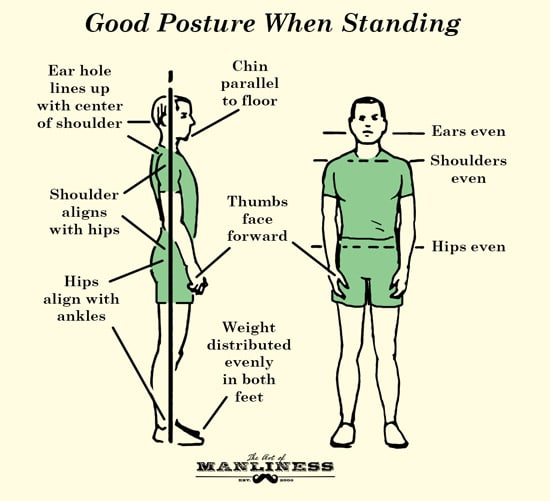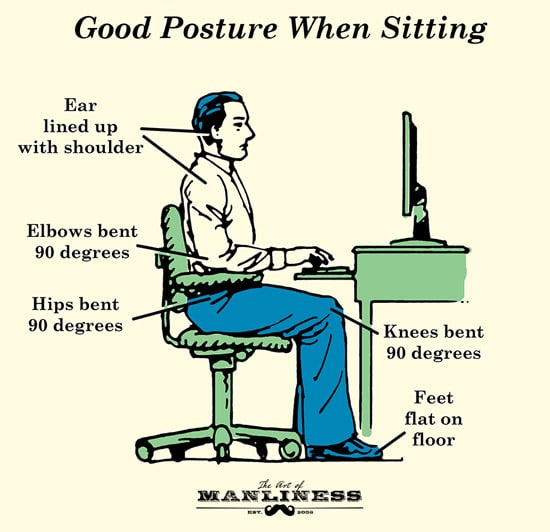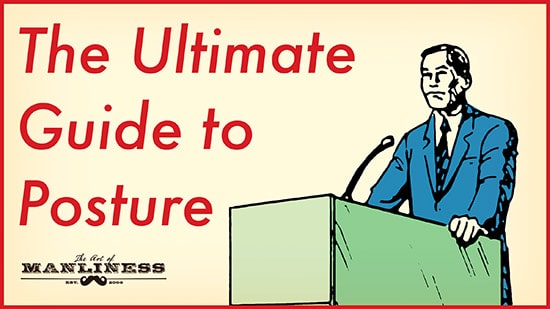
Take a peek into most every office in America. What do you see? Workers hunched over their computers. Look at your fellow commuters on the subway. How do they sit? Slumped over their smartphones. Survey the friends and loved ones around you. How do they stand and walk? Likely a little stooped over.
Industrialization brought an increase in sitting to the modern world. And modern technology has given us devices that we hold and view while hunched over. Yet these advancements are ironically devolving our species a bit; part of what makes us human is our ability to walk upright, and yet here we are creeping around where we once stood tall.
To get us humans moving forward again into what Winston Churchill called “the broad sunlit uplands” of a bright and upright future, I’ve spent the last few months researching the benefits and mechanics of good posture, and how to achieve it in an age of schlumpliness.
Today I’m going to share everything I learned. I don’t think you’ll find a more thorough or clear guide to posture on the web, so sit up straight, friends, and read on.
The Benefits of Good Posture
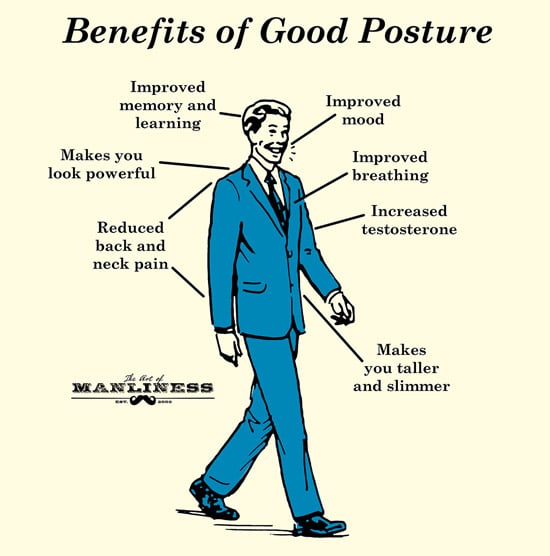
Improves bodily alignment. When you stand and sit with your body properly aligned, all your organs can function as intended. This includes your stomach, which is why good posture may improve digestion.
Eliminates back and neck pain. When you have proper posture, your bones and spine can easily and efficiently balance and support your body’s weight. When you have improper posture, muscles, tendons, and ligaments have to constantly work to support that same weight. This extra, inefficient effort can lead to back and neck pain as well as tension headaches. Focusing on improving your posture can go a long way to remedying these problems.
Improves breathing. To work efficiently, your lungs need room to expand in your chest. When you’re slumped over, your rib cage collapses a bit, leaving less room for your lungs to open, which in turn causes inefficient breathing.
Improves memory and learning. Recent research has shown there may be a connection between good posture and memory retention when learning new things. Why? It’s theorized that since good posture enhances your breathing, it allows you to take in more oxygen, and when you take in more oxygen, your cognition improves. (Fast fact: your brain uses about 25% of all the oxygen in your body.)
Makes you look taller and slimmer. Some poor posture positions cause your belly to protrude, giving you a “beer belly” profile. And slumping over makes you appear shorter than you are. Standing up straight will correct these issues and improve your appearance.
Makes you look confident and powerful. When we stand in an upright position, people perceive us as having high status. There are a few reasons why:
First, as we discussed in our series on the nature of status, height and physique are two embodied status markers humans use to size each other up. Research shows that taller, fitter-looking men are not only judged to be more attractive by the opposite sex, they also earn more over their lifetime than shorter and overweight men. While you can’t do much about the height that God has given you, you can make the most of what you’ve got by standing up straight with proper posture.
Second, an open, upright stance is simply perceived as more authoritative and dominant. You see this even with animals. When chimps or dogs are submissive, they’ll bow their heads and make themselves look small. Dominant animals, on the other hand, stand up straight and take up more room. An upright posture is a “power pose” that conveys confidence and status to other humans.
Finally, good posture makes your seem more trustworthy. There’s a reason being “upright” and “standing tall” are used to describe someone who’s virtuous and committed to their principles. Those who slump seem to be burdened by some weight — perhaps that of their faults and deceptions. Men who stand straight are thus perceived as open and honest.
Makes you feel confident and powerful. There’s a reason militaries have focused for more than a century on giving their soldiers posture training. They’ve seen that standing straight improves troops’ bearing and morale, and now modern researchers have started to prove this intuitive observation.
Studies have emerged that illuminate the power of the mind/body connection and particularly how physical posture and body language affects how we feel mentally and emotionally. What researchers are finding is not only does having good posture make you seem powerful to others, it makes you feel powerful yourself.
The big reason why? Testosterone.
In Presence, social psychologist Amy Cuddy highlights studies that show how assuming “power poses” — including standing with good, upright posture — increases testosterone and decreases cortisol in the body. On average, assuming a power pose causes a 16% increase in testosterone and an 11% decrease in cortisol within minutes. This increase in T and decrease in stress hormones causes people to feel less anxious and more confident. She and her research team found that after assuming a power pose or just standing with good, upright posture, individuals were more apt be assertive, proactive, and comfortable taking risks.
If you struggle with passivity and a lack of motivation, start focusing on your posture. It’s not a silver bullet, obviously, and it won’t immediately turn you into a confident and assertive He-Man overnight. But it can help, and it’s so easy to do, there’s no reason not to try it.
Improves concentration and mental performance. A study done by Colorado College showed that male students with the best sitting posture scored significantly higher on tests than students who slouched.
The increased concentration and mental performance is likely caused by the increased testosterone and decreased cortisol levels just discussed. As Dr. Tomi Ann Roberts, the lead author of the study, concluded: “an upright posture makes people feel dominant and successful, which in turn improves their ability to relax and focus on problems.”
Improves mood. Not only can standing and sitting with good posture make you feel more confident and powerful, it can also boost your happiness. One study found that when people assumed slouched or slumped postures while asked to recall memories, they were more likely to remember sad and depressive episodes. Individuals in upright positions, on the other hand, were more likely to recall happy and positive memories. If you’re a man who struggles with the black dog, give yourself a leg up on your melancholy, by keeping up your posture.
The Two Myths of Good Posture
So having good posture comes with big benefits. But what does good posture look like?
When most people think of good posture, they’re usually thinking of it in terms of two myths we should get out of the way before we go any further:
Posture Myth #1: Good posture should feel rigid and take a lot of work. When most people hear “good posture,” they imagine a soldier standing at attention with their chest puffed out and their back and shoulders stiff, pulled back, and tensed up. But this is actually bad posture (and despite our perceptions, isn’t the way actual soldiers are taught to stand either). This imaginary soldier stance causes your muscles and tendons to work hard to maintain an unnatural position. If you’ve felt sore after a day of focusing on good posture, chances are it’s because you spent your time trying to pull yourself into this pose.
Good posture should actually feel relaxed and easy. When you have good posture, your bones, not your muscles, keep your body upright and balanced. Even though you’re sitting and standing straighter than you usually do, you shouldn’t feel tense or strained.
Now, if you’ve done a lot of sitting and slumping in your life, getting into good posture position isn’t going to feel effortless at first. You shouldn’t feel strained, but you may feel tight. To ease this tightness, read and implement the tips in the last section of this article.
Posture Myth #2: There’s one ideal posture everyone should be aiming for. Contrary to popular belief, there’s no one exact standard for what constitutes good posture. Everyone’s body is different, so good posture for one man won’t necessarily look the same for another. With that said, there are a few cues we can all use to find our ideal posture, whether sitting or standing.
How to Achieve Good Posture
Your overall goal with posture is to have a “neutral spine.” A neutral spine retains three natural curves: a small hollow at the neck’s base, a small roundness at the middle back, and a small hollow in the lower back. Below we show you what to focus on to get that neutral spine while standing or sitting. First, we give a full explanation of what to do and why; this is followed by a “crib sheet” of posture “cues” to check for throughout the day.
Good Posture While Standing
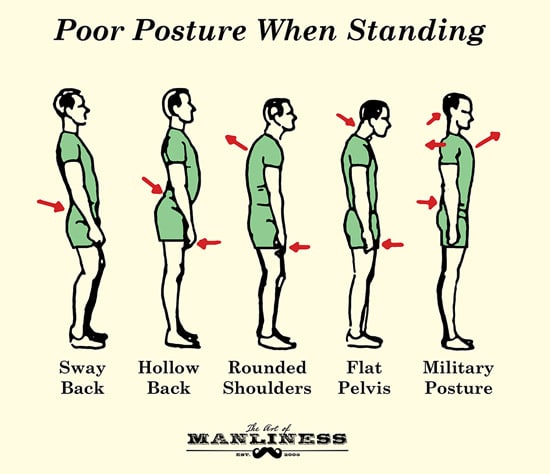
To achieve correct posture while standing, the ears, shoulders, hips, knees, and ankles should align in one straight line. To give you a mental image of what good posture looks like, imagine a plumb line running from your earlobe. If you have correct posture, the line would hang straight to the middle of your anklebone.
A big issue people have with achieving a neutral spine is getting the shoulders to line up where they should be. Most folks with bad posture have shoulders that round forward, giving them that Quasimodo look. If you can’t tell if you’re rounding your shoulders forward, here’s a quick test:
Hang your hands down by your side. If the backs of your hands face forward, then you’ve got rounded shoulders. If your thumbs face forward, then your shoulders should be aligned for good posture.
Where most folks mess up with shoulder alignment and their posture is that they overcompensate, moving their shoulders back and drawing together their shoulder blades to overcome forward shoulder rounding. Maintaining this position requires your back and shoulder muscles to tense up and contract. Again, when you have good posture, your muscles should do as little work as possible to maintain your posture.
If you have a hard time taking that mental picture of good posture and moving your body to fit it, do this wall exercise:
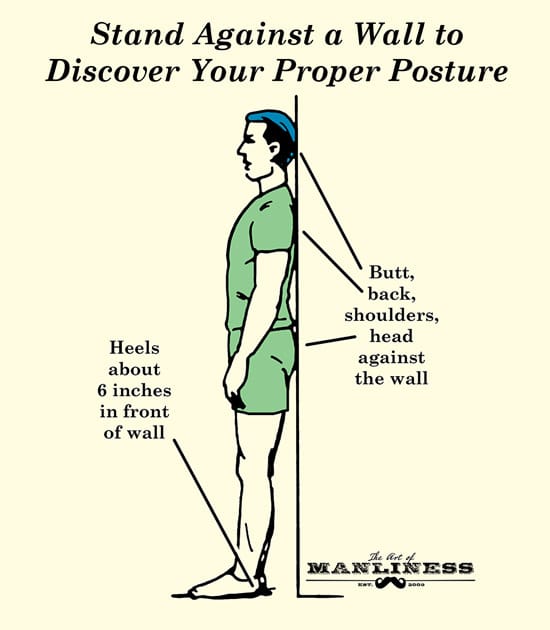
Stand with head, shoulders, and back against a wall and your heels about 5-6 inches forward. Draw in the lower abdominal muscles, decreasing the arch in your lower back. This is what good posture feels like. Now push away from the wall and try to maintain this upright, vertical alignment.
Cues for Good Posture While Standing
- Weight should feel evenly distributed on both feet while standing. If someone could push you at the sternum and easily make you lose your balance, then your bodyweight isn’t evenly distributed in your feet.
- Looking from the side, your ear hole, point of the shoulder, hips, and ankles should line up vertically on top of each other.
- Chin should be parallel to the floor.
- Looking at yourself from the front, your left and right shoulder should be evenly aligned as should your left and right hipbones.
Good Posture While Sitting

Sitting improperly is the single most detrimental thing to our posture. Instead of using our skeleton to support our weight, we let our chairs do all the work. Unfortunately, this has a tendency to cause us to slump and slouch. Combine that with hunching over your laptop and computer to get closer to the screen, and you’ve got a perfect storm for poor posture.
It’s harder to maintain good posture while sitting than standing, so the first thing you can do to mitigate its ill effects is simply to start sitting less. Take a break every 30 to 45 minutes to get up and move your body. Walk around and do some stretches or even the desk jockey workout. If your office allows it, use a standing desk, keeping in mind that standing in place all day is probably just as bad as sitting all day. Use a standing desk with moderation, alternating between sitting and standing throughout the day.
When you do sit, focus on keeping your ears and shoulders lined up. That will go a long way in avoiding the shoulder slumping that often occurs when working at a desk. Again, you don’t need to strain your shoulders backwards, and you shouldn’t feel like you have to tense up to hold them back; just align them with your ears and keep them relaxed. If you’re having a hard time with that, a neat little hack I found on Breaking Muscle is to get a cheap inflatable travel pillow and put it around your neck while you work. When you start bringing your head forward and your shoulders up, you’ll feel the pillow pressing against your ears, reminding you to move your head and shoulders back to a neutral spine position.
Another thing to focus on while sitting is to make sure your feet rest flat on the floor, with your knees and hips bent 90 degrees. Your elbows should also bend at 90 degrees while typing or resting on the arm rests of your chair. If your knees, hips, and elbows aren’t bent correctly, adjust your chair until they are.
Cues for Good Posture While Sitting
- Ears are above the points of your shoulders.
- Shoulders are back (don’t slump forward!), but nice and relaxed.
- Feet flat on the floor with knees, hips, and elbows bent 90 degrees.
- Take frequent breaks to stand up and move around.
Avoid the Smartphone Slump

A few weeks ago we published an article on why and how to quit the smartphone habit. If increased focus and human connection weren’t enough of a reason for you to unglue yourself from your phone, here’s another: your smartphone is destroying your posture. Mobility and posture experts have started calling the position we put ourselves in while looking at our phones — crouched over with our hands/phones down at our bellies — “Smartphone Slump.”
The average adult human head weighs about 11 pounds; about the weight of a light bowling ball. When you have good posture, your head lines up on top of your spinal column. The force you exert to keep your head in this neutral position is equal to the weight of your head.
But as you move your head forward, the force needed to keep your head up starts to increase. With just a 15-degree tilt forward, that bowling ball of a head of yours feels like 27 pounds. At 30 degrees, it increases to 40 pounds. When you tilt your head forward 45 degrees, it’s exerting almost 50 lbs of force on your upper body.
When you tilt your head down, instead of your bones doing all the work of holding your head up, your muscles have to start contracting to help get the job done. It starts with the trapezius muscles that run along the length of your neck and on top of your shoulders (this is why your neck gets sore whenever you look down at your phone a lot). When your traps contract like this, it causes your chest to sink and your shoulders to roll forward a bit, giving you a hunchback.
Not only does the Smartphone Slump wreak havoc on your muscles, some cognitive psychologists speculate it may even play a factor in the increasing rate of depression in the West. As mentioned above, slouched positions can make us feel sad and depressed. The Smartphone Slump is the type of slouched, submissive position that can lead to low mood (the fact that you’re slumping over while scrolling through your Instagram feed, and feeling the burden of FOMO, probably doesn’t help either.)
Counteracting Smartphone Slump is easy. Just don’t look down at your phone and instead bring your phone up to eye level. Yes, you’ll look goofy and like you’re constantly taking selfies, but it will keep that big ol’ bowling ball of a head balanced on top of your spine and relieve the muscles in your back, shoulders, and neck.
Corrective Exercises to Counteract Years of Bad Posture
Just focusing on and being cognizant of having good posture can go a long way to improving your posture. But if you’ve spent years in slouched and slumped positions while standing and sitting, you shoulders, traps, and chest muscles are likely super tight. And that tightness will make it hard to stay in a nice, neutral spine position throughout your day.
But there is hope! With time and effort, you can loosen up these slouching muscles so that attaining good posture becomes easier and easier. Here’s how:
Do the De-Quasimodo Routine. Last year, we presented an entire mobility routine aimed at reducing slouching. We called it the “De-Quasimodo Yourself” Routine. It focuses on increasing flexibility in your chest, shoulders, and upper back. It’s a routine you’ll need to do consistently. You can’t just do it once and expect immediate results. But it will enable you to achieve good posture much more easily.
Stand against a wall. If you’re having a hard time maintaining proper posture throughout the day, do the wall exercise mentioned above for a few minutes at a time. Staying in that position can do a lot to open up the muscles in your chest and shoulders.
Static back. This one feels amazing. Lie on the floor and place your legs on top of a bed, chair, or ottoman. Your knees should bend at a 90-degree angle. Get your hips as close to the chair (or whatever you’re using to rest your legs on) as possible. Lay your arms on the ground at your side. Just lie there like this for 5 to 10 minutes.
This position lines up your shoulders with your hips and helps relax the muscles in your lower back (an area that’s often tight due to bad posture). It also helps stretch your thoracic muscles.
Static wall. This is a more intense version of the static back stretch. Instead of resting your legs on the bed, you’re going to put your legs up on a wall. To perform this stretch, lie on the floor with a wall in front of you. Bring your legs up the wall and scoot your butt as close to the wall as possible. You should look like you’re sitting on the wall. Rest your arms out to your side. Hold this position for 5 minutes. You’ll get the same stretch as with the static back, it will just feel more intense.
Standing straight and upright and enjoying your full humanness is within reach — it just takes some intentionality and consistent work. Stand tall and walk on my friends!


